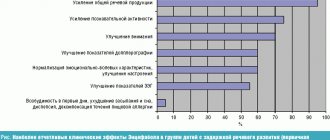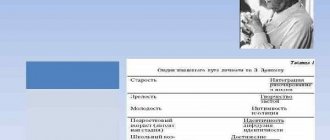General information
The localization of the pathological process leading to dysarthria in children can develop at different levels of the nervous system responsible for the formation of sounds and the logical order of the story:
- nuclei of the cranial nerves responsible for the nervous control of the tongue, lips, soft palate, etc.;
- pathways between the cortex and cerebral nuclei;
- subcortical centers;
- the cerebellum and pathways, pathways from and to it;
- cortex.
Diagnosis is carried out simultaneously by a neurologist (determines the level of topical damage to the nervous system and the nature of the pathological process) and a speech therapist (determines the degree of speech disorders in order to make a correction prognosis).
Treatment is aimed at eliminating or stabilizing the background pathology that led to speech disorders, as well as articulatory correction.
Symptoms
Dysarthria is a deviation characterized by unclear, incomprehensible, slurred speech due to the fact that the muscles of the soft palate, tongue, larynx, vocal cords, and respiratory muscles function poorly. Defects in the presence of this disease are varied, and many of them overlap with other types of speech disorders, for example, there is a weak, quiet, muffled, nasal voice. Dysarthria is diagnosed based on the following symptoms:
- muscle hypotension;
- muscular dystonia;
- muscle spasticity;
- violations of sound pronunciation - erased dysarthria is characterized by blurred speech, more severe degrees - slow speech, slurring, omission of sounds, distortions, at 4 degrees - absence of speech.
Specific features that manifest dysarthria in children and adults are persistence of defects, learning difficulties, a longer period for automation, violation of both vowels and consonants, interdental and lateral pronunciation of sibilants and sibilants. Illness in children may be accompanied by OHP and dysgraphia.
Classification
There are several options for classifying childhood dysarthria. The most common of them is associated with the localization of a pathological focus that affects the functioning of the speech center. The following forms of the disease are distinguished:
- pseudobulbar (most common);
- bulbar;
- extrapyramidal (subcortical);
- cerebellar;
- cortical.
Depending on the degree of damage and the severity of the main symptoms, the following forms of dysarthria are distinguished:
- erased: characterized by minimal pronunciation disorders;
- moderate: severe articulation defects, slurred speech, quiet voice;
- anarthria: complete absence of speech or isolated sounds.
Correction
Correction of dysarthria by a speech therapist is carried out in conjunction with all procedures and treatment prescribed by a neurologist.
Treatment of dysarthria in terms of neurology consists of a set of measures and procedures, which are selected individually depending on the severity of the concomitant disease. The patient may be prescribed:
- drug therapy;
- segmental reflex and acupressure massage;
- acupuncture;
- acupressure;
- exercise therapy;
- medicinal baths;
- physiotherapy;
- mechanotherapy;
- hirudotherapy.
In addition to standard hospital procedures, activities with creative elements (sand therapy, isotherapy), as well as touch therapy, finger exercises and dolphin therapy are well suited for the rehabilitation of patients.
Correction of the disease by the efforts of a speech therapist is carried out in parallel and includes speech therapy massage and gymnastics (breathing, articulation), orthophonic exercises, practicing and automating correct sound pronunciation. The list of procedures and techniques that will be included in the treatment of pathology depends on the cause of the defect and its severity.
To make an appointment, call us at the numbers on the website or use the special form. Neurologists and speech pathologists-speech pathologists from our network of Nearmedic clinics will provide comprehensive support to both children and adults. The frequency of visits to a speech therapist is 2-4 sessions per week.
Symptoms of dysarthria in children
The pathogenetic mechanisms of dysarthria are multifaceted and are associated with inadequate innervation of organs involved in speech formation. These are the respiratory muscles, muscles of the lips, tongue and soft palate, larynx and vocal folds. As a result, speech becomes slurred and unclear. Concomitant signs of dysarthria in children are associated with impaired innervation of the muscles responsible for the pronunciation of sounds. Depending on the type of disorder, symptoms vary slightly:
- Muscle spasm. Tension of the lips, tongue, face and neck. The lips are tightly closed. Limitation of movements when pronouncing sounds.
- Muscle hypotension. The tongue is flaccid and lies almost motionless on the floor of the mouth. The mouth is half open, because lips do not close. There is increased salivation. Due to the immobility of the soft palate, the voice acquires a nasal tint (becomes nasal).
With dysarthria, the pronunciation of almost all sounds is impaired - both consonants and vowels.
The child softens hard consonants. When pronouncing hissing and whistling sounds, the tongue moves not forward, but to the side, and the interdental spaces are involved. Due to a complex disturbance of innervation, the characteristics of the voice also change. He becomes quiet, weak, deaf, acquires a nasal tone, etc. An imbalance in the control of the respiratory act leads to the fact that exhalation is shortened, and when speaking, breathing becomes more frequent and intermittent.
Due to slurred speech, the child cannot clearly differentiate sounds by ear. This leads to an unformed vocabulary and the inability to construct a grammatically correct sentence. Therefore, it is so important not to waste time and begin correcting speech disorders as early as possible.
Features of a child with erased dysarthria
Erased dysarthria occurs very often in speech therapy practice. The main complaints with erased dysarthria: slurred, inexpressive speech, poor diction, distortion and replacement of sounds in words with complex syllable structure, etc.
Erased dysarthria is a speech pathology that manifests itself in disorders of the phonetic and prosodic components of the speech functional system and arises as a result of unexpressed microorganic damage to the brain (L.V. Lopatina).
A survey of children in mass kindergartens showed that in senior and preparatory school groups from 40 to 60% of children have deviations in speech development. Among the most common disorders: dyslalia , rhinophonia, phonetic-phonemic underdevelopment, erased dysarthria .
In groups for children with general speech underdevelopment, up to 50% of children, and in groups with phonetic-phonemic underdevelopment, up to 35% of children have erased dysarthria. Children with severe dysarthria need long-term, systematic individual speech therapy assistance. Speech therapists of specialized groups plan speech therapy work as follows: in frontal, subgroup classes with all children they study program material aimed at eliminating general speech underdevelopment, and in individual classes they correct the pronunciation side of speech and prosody, i.e. elimination of symptoms of erased dysarthria.
The erased form of dysarthria is most often diagnosed after five years. All children whose symptoms correspond to erased dysarthria are sent for consultation to a neurologist to clarify or confirm the diagnosis and to prescribe adequate treatment, because in case of erased dysarthria, the method of correctional work should be comprehensive and include: - medical intervention; — psychological and pedagogical assistance; - speech therapy work.
For early detection of erased dysarthria and proper organization of complex effects, it is necessary to know the symptoms that characterize these disorders. The examination of the child begins with a conversation with the mother and study of the child’s outpatient development chart. Analysis of anamnestic information shows that there are: deviations in intrauterine development (toxicosis, hypertension, nephropathy, etc.); asphyxia of newborns; rapid or prolonged labor. According to the mother, “the child did not cry right away; the child was brought in to be fed later than everyone else.” In the first year of life, many were observed by a neurologist and prescribed medication and massage. The diagnosis for up to a year was “PEP” (perinatal encephalopathy). The development of a child after one year, as a rule, is successful for everyone, the neurologist no longer observes these children, and the child is considered healthy. When examined in a clinic by a speech therapist, children aged 5-6 years with erased dysarthria reveal the following symptoms:
GENERAL MOTOR SKILLS. Children with erased dysarthria are motorically awkward, the range of active movements is limited, and the muscles quickly tire during functional loads. They stand unsteadily on one leg, cannot jump on one leg, walk along a “bridge,” etc. They imitate movements poorly: how a soldier walks, how a bird flies, how bread is cut, etc. Motor incompetence is especially noticeable in physical education and music classes, where children lag behind in tempo, rhythm of movements, as well as in switching movements.
FINE MOTOR SKILLS OF HAND. Children with erased dysarthria late and have difficulty mastering self-care skills: they cannot button a button, untie a scarf, etc. During drawing classes, they don’t hold a pencil well and their hands are tense. Many people don't like to draw. Motor clumsiness of the hands is especially noticeable during applique classes and with plasticine. In works on appliqué, difficulties in the spatial arrangement of elements can also be traced. Violation of fine differentiated movements of the hands is manifested when performing sample tests of finger gymnastics. Children find it difficult or simply cannot perform an imitation movement without outside help, for example, “lock” - put their hands together, intertwining their fingers; “rings” - alternately connect the index, middle, ring and little fingers with the thumb, and other finger gymnastics exercises.
During origami classes they experience great difficulties and cannot perform the simplest movements, because... both spatial orientation and subtle differentiated hand movements are required. According to mothers, many children under 5-6 years old are not interested in playing with construction sets, do not know how to play with small toys, and do not assemble puzzles.
School-age children in the first grade experience difficulties in mastering graphic skills (some experience “mirror writing”; substitution of letters “d” - “b”, vowels, word endings; poor handwriting; slow pace of writing, etc.).
FEATURES OF THE ARTICULATING APPARATUS. In children with erased dysarthria, pathological features in the articulatory apparatus are revealed. Pareticity of the muscles of the organs of articulation is manifested in the following: the face is hypomimic, the facial muscles are flaccid upon palpation; Many children do not maintain the closed mouth pose, because the lower jaw is not fixed in an elevated state due to laxity of the masticatory muscles; lips are flaccid, their corners are drooping; During speech, the lips remain flaccid and the necessary labialization of sounds is not produced, which worsens the prosodic aspect of speech. The tongue with paretic symptoms is thin, located at the bottom of the mouth, flaccid, the tip of the tongue is inactive. With functional loads (articulation exercises), muscle weakness increases. Spasticity of the muscles of the organs of articulation is manifested in the following: the face is amicable, the facial muscles are hard and tense on palpation. The lips of such a child are constantly in a half-smile: the upper lip is pressed against the gums. During speech, the lips do not take part in the articulation of sounds. Many children who have similar symptoms do not know how to perform the “tube” articulation exercise, i.e. pull the lips forward, etc. With a spastic symptom, the tongue is often changed in shape: thick, without a pronounced tip, inactive.
Hyperkinesis with erased dysarthria manifests itself in the form of trembling, tremor of the tongue and vocal cords. Tremor of the tongue appears during functional tests and loads. For example, when asked to support a wide tongue on the lower lip with a count of 5-10, the tongue cannot maintain a state of rest, trembling and slight cyanosis appear (i.e., blue tip of the tongue), and in some cases the tongue is extremely restless (waves roll through the tongue in longitudinal or transverse direction). In this case, the child cannot keep his tongue out of the mouth. Hyperkinesis of the tongue is often combined with increased muscle tone of the articulatory apparatus.
Apraxia with erased dysarthria is simultaneously detected in the inability to perform any voluntary movements with the hands and organs of articulation. In the articulatory apparatus, apraxia manifests itself in the inability to perform certain movements or when switching from one movement to another. Kinetic apraxia can be observed when the child cannot smoothly transition from one movement to another. Other children experience kinesthetic apraxia, when the child makes chaotic movements, “groping” for the desired articulatory position. Deviation, i.e. deviation of the tongue from the midline, also manifests itself during articulation tests and during functional loads. Deviation of the tongue is combined with asymmetry of the lips when smiling with a smoothness of the nasolabial fold.
Hypersalivation (increased salivation) is detected only during speech. Children cannot cope with salivation, do not swallow saliva, and the pronunciation side of speech and prosody suffer.
When examining the motor function of the articulatory apparatus in children with erased dysarthria, the ability to perform all articulation tests is noted, i.e. Children, according to instructions, perform all articulatory movements - for example, puff out their cheeks, click their tongue, smile, stretch out their lips, etc. When analyzing the quality of performing these movements, one can note: blurriness, unclear articulation, weakness of muscle tension, arrhythmia, decreased range of movements, short duration of holding a certain pose, decreased range of movements, rapid muscle fatigue, etc. Thus, under functional loads, the quality of articulatory movements sharply falls. During speech, this leads to distortion of sounds, their mixing and deterioration in the overall prosodic aspect of speech.
SOUND PRONUNCIATION. When first meeting a child, his sound pronunciation is assessed as complex dyslalia or simple dyslalia. When examining sound pronunciation, the following are revealed: confusion, distortion of sounds, replacement and absence of sounds, i.e. the same options as for dyslalia. But, unlike dyslalia, speech with erased dysarthria also has disturbances on the prosodic side. Impaired pronunciation and prosody affect speech intelligibility, intelligibility, and expressiveness. Some children go to the clinic after classes with a speech therapist. Parents ask why the sounds that the speech therapist provided are not used in the child’s speech. The examination reveals that many children who distort, omit, mix or replace sounds can pronounce these same sounds correctly in isolation. Thus, sounds in erased dysarthria are produced in the same ways as in dyslalia, but for a long time they are not automated and are not introduced into speech. The most common violation is a defect in the pronunciation of whistling and hissing sounds. Children with erased dysarthria distort and mix not only articulatory complex sounds that are close in place and method of formation, but also acoustically opposed ones. Quite often, interdental pronunciation and lateral overtones are noted. Children have difficulty pronouncing words with a complex syllabic structure; they simplify the sound content by omitting some sounds when consonants are combined.
PROSODICA. The intonation-expressive coloring of the speech of children with erased dysarthria is sharply reduced. The voice, vocal modulations in pitch and strength suffer, speech exhalation is weakened. The timbre of speech is disrupted and sometimes a nasal tone appears. The pace of speech is often accelerated. When reciting a poem, the child’s speech is monotonous, gradually becomes less intelligible, and the voice fades away. The children's voice during speech is quiet, modulation in pitch and voice strength is not possible (the child cannot change the pitch of the voice by imitation, imitating the voices of animals: cows, dogs, etc.). In some children, speech exhalation is shortened, and they speak while inhaling. In this case, speech becomes choked. Quite often, children are identified (with good self-control) in whom, during a speech examination, deviations in sound pronunciation do not appear, because They pronounce the words in a chant, i.e. by syllables, and only violation of prosody comes first.
GENERAL SPEECH DEVELOPMENT. Children with erased dysarthria can be divided into three groups. First group. Children who have impaired sound pronunciation and prosody. This group is very similar to children with dyslalia. Often, speech therapists treat them as dyslastic, and only in the process of speech therapy work, when there is no positive dynamics in the automation of sounds, does a suspicion arise that this is erased dysarthria. Most often, this is confirmed during an in-depth examination and after consultation with a neurologist. These children have a good level of speech development, but many of them have difficulty learning, distinguishing and reproducing prepositions. Children confuse complex prepositions and have problems distinguishing and using prefixed verbs. At the same time, they speak coherent speech and have a rich vocabulary, but may have difficulty pronouncing words with a complex syllabic structure (for example, frying pan, tablecloth, button, snowman, etc.). In addition, many children experience difficulties with spatial orientation (body diagram, concepts of “below-above,” etc.).
Second group. These are children in whom a violation of sound pronunciation and the prosodic side of speech is combined with the incomplete process of forming phonemic hearing. In this case, children encounter isolated lexical and grammatical errors in their speech. Children make mistakes in special tasks when listening and repeating syllables and words with oppositional sounds - for example, when asked to show the desired picture (mouse-bear, fishing rod-duck, scythe-goat, etc.).
Thus, in children, the auditory and pronunciation differentiation of sounds is unformed. Children's vocabulary lags behind the age norm. Many people experience difficulties in word formation, make mistakes in agreeing a noun with a numeral, etc. Sound pronunciation defects are persistent and are regarded as complex, polymorphic disorders. This group of children with phonetic-phonemic underdevelopment (FFN) and erased dysarthria should be referred by the speech therapist of the clinic to the MPC (medical-pedagogical commission), to a specialized kindergarten (to the FFN group).
Third group. These are children who have a persistent polymorphic disorder of sound pronunciation and a lack of prosodic aspect of speech combined with underdevelopment of phonemic hearing. As a result, the examination reveals a poor vocabulary, pronounced errors in grammatical structure, the impossibility of a coherent statement, and significant difficulties in mastering words of different syllabic structures.
All children in this group demonstrate undeveloped auditory and pronunciation differentiation. Ignoring prepositions in speech is indicative. These children with erased dysarthria and general speech underdevelopment (GSD) should be sent to MPC (in specialized kindergarten groups) to GSD groups. Thus, children with erased dysarthria are a heterogeneous group. Depending on the level of development of linguistic means, children are sent to specialized groups: - with phonetic disorders; - with phonetic-phonemic underdevelopment; - with general speech underdevelopment .
(according to E. F. Arkhipova)
Do you need a speech therapist in Sviblovo? Sign up for a consultation by phone or through the feedback form in the “Contacts” section.
Causes of dysarthria
Among the most common causes of dysarthria in children are:
- toxicosis;
- antenatal hypoxia;
- immune conflict according to the ABO system and the Rh factor;
- chronic pathologies in a mother carrying a child;
- complicated course of labor;
- birth injuries;
- birth before 37 weeks;
- asphyxia.
All these factors can lead to organic brain damage, incl.
centers responsible for speech development. At the same time, cerebral palsy often develops, and its severity correlates with the severity of speech disorders. In addition, dysarthria can develop in early childhood in an initially healthy child. In this case, the reasons lie in severe neuroinfections and intoxications, for example, carbon monoxide, alcohol poisoning, etc., as well as tumors and brain injuries.
Diagnosis of dysarthria in children
Dysarthria in children is a disorder that is often accompanied by other neurological symptoms and disorders, so the child must be examined not only by speech therapists, but also by neurologists.
The neurologist conducts an objective examination, assesses the severity of reflexes and prescribes additional diagnostic methods. As a rule, neurosonography is an ultrasound examination of the brain that allows identifying focal lesions. Rheoencephalography and encephalography may also be performed.
Speech therapy testing is aimed at assessing speech and non-speech disorders. Non-speech parameters:
- development of facial and speech muscles;
- range of motion in the temporomandibular joint;
- breathing pattern, etc.
Speech assessment parameters:
- pronunciation;
- synchronicity of the work of organs involved in the formation of speech;
- correct pronunciation of sounds, construction of sentences, etc.
Based on a comprehensive examination, the severity of dysarthria is determined. There are 4 degrees of speech impairment:
- First degree (erased form) - speech disorders are invisible to others and are detected only during a speech therapy examination.
- Second degree – speech is understandable, but there are defects in the pronunciation of sounds.
- Third degree - speech becomes slurred, only people from close circle understand it.
- The fourth degree (anarthria) – speech is completely slurred, even people who are constantly with the child cannot understand it.
Treatment of dysarthria
Treatment of dysarthria in children depends on the severity of symptoms, the cause of the disease and the location of the pathological focus.
Regardless of the form of the disorder, therapy includes two basic areas: therapeutic (neurological) and speech therapy. A neurologist provides therapy for the underlying disease that has led to speech impairment. For this purpose, vascular drugs, nootropics, vitamins and others can be prescribed. If there is a brain tumor compressing the speech center, removal is indicated (at this stage a neurosurgeon is involved).
Speech therapy methods for working with a child suffering from dysarthria include:
- stabilization of the tone of the muscles responsible for articulation: speech therapy massage, taping, speech gymnastics;
- exercises aimed at developing motor skills: rhythm, finger gymnastics, etc.;
- breathing control and voice control training;
- production of sounds;
- development of vocabulary, etc.
It takes a lot of time to correct violations. It is important to remember that both doctors and speech therapists, as well as parents, should treat dysarthria in a child. Regular training and exercises at home also contribute to the speedy restoration of speech functions.
In achieving the desired results, the start of therapy as early as possible, the diligence of the parents and the patient himself are of great importance. SM-Doctor specialists build a program of work with the child in such a way that motivation to achieve the goal does not disappear at any stage, but only increases. This and the high professionalism of speech therapists, neurologists and other doctors involved make it possible to achieve high results and restore speech intelligibility.
Diagnostic and treatment methods
The Clinical Institute of the Brain specializes in the diagnosis and treatment of speech activity disorders, including those caused by disorders of nervous activity. An important stage is an examination by a speech therapist, during which even hidden forms of dysarthria are identified. The procedure consists of several stages, during which the correctness of breathing and uniformity of speech, reproduction of individual sounds and conscious word combinations are assessed. The patient is also asked to undergo certain tests that reveal the degree of development of written speech. This can be either rewriting fragments of text or writing from dictation, as well as awareness of written speech.
Additional diagnostic stages are aimed at identifying the area of the nervous system in which the lesion is located. This is possible thanks to specific techniques:
- electrophysiological studies, including electroencephalography and assessment of facial muscle activity;
- study of the brain using transcranial magnetic radiation;
- MRI of the brain.
Treatment of dysarthria is a long process that is completely under the control of doctors at the Clinical Brain Institute. The therapy is aimed at strengthening neural connections and stimulating the conduction of nerve impulses, as well as improving speech activity. The main condition for positive dynamics is the work of a competent speech therapist and neurologist, as well as systematic training. A good therapeutic effect is achieved through physiotherapy, physical therapy, and special massage techniques (reflex, acupressure). In addition, spa treatment is recommended, including those aimed at improving the patient’s communication abilities. Spending time with animals is beneficial - most experts recommend hippotherapy. The prognosis depends on the stage of the disease, as well as on the timeliness of its diagnosis and systematic treatment. With mild dysarthria, complete restoration of speech function is possible, with severe dysarthria, its partial improvement.
Prognosis and prevention
The result of treatment depends on the type of disorder and its degree. Regularity of exercise is important. Only constant training and thorough implementation of the doctor’s recommendations will allow you to completely or partially cope with the problem. If we are talking about severe disability, in which dysarthria arose against the background of other pathologies, the likelihood of successful correction is significantly reduced.
Prevention of the disease includes general measures: reducing the risk of injury, a healthy lifestyle during pregnancy, etc.
As soon as you begin to notice the first signs of dysarthria in a preschooler, do not delay your visit to specialists. Only a comprehensive specialized examination will identify or eliminate the problem. At SM-Doctor you will be met by competent doctors and speech therapists who will help you establish an objective diagnosis and correct the identified disorders. Sign up for a consultation with professionals at a convenient time! We find an approach to every child, even the most difficult.











